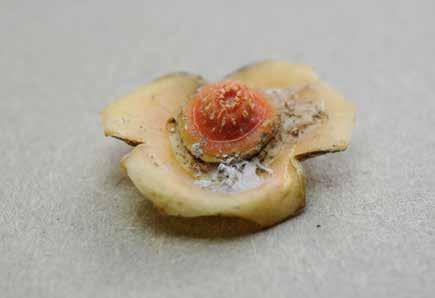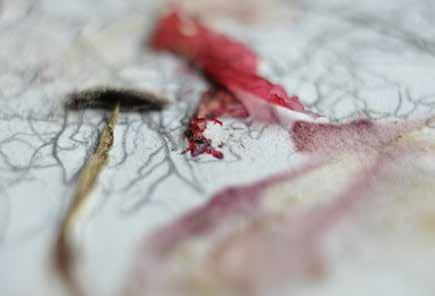Recordings
Jennie TaylorA text in response to Dust by Ann Henderson

 Ann Henderson, Studio Processes
Ann Henderson, Studio Processes


 Ann Henderson, Studio Processes
Ann Henderson, Studio Processes
Early morning customers were her favourite, not because they were organised, but because they were the most shaken by her consultation. For example, one morning, in came a slightly irked and impatient local. They brought a ceramic ornament, a classic. The customer expected the service to date antiques. The machinist explained the process of identifying precise, internal time measurements inside of any inanimate thing, no matter how long it has existed. This customer was dismissive and curious in equal measure, so they decided to stay for the process and see it for themselves.
Her shop was cluttered with objects arranged in their own momentary order, on shelves, tables and temporary surfaces, ladder steps and chairs. An available spot was swiftly populated. A family business, the shop, was a mystery to most and a truth to few. Weekends were busy. Her customers were usually regulars. Forgotten objects were displayed in the shop, left behind from drawn-out consultations. Some objects were sticky and difficult to read. Her profession was rare but not totally unknown and her role title was slippery, but it was safe to call her a machinist.

The machinist assessed the ceramic object superficially, noting its appearance, wear and tear, things like that. She then measured thickness and quantity of dust. A general rule of thumb was one month at the rate of roughly a year was an accumulation of one millimetre of dust. A concept which takes decades to fully understand. She went into her back room with the expectation to be in there for a few days because ceramic, although inherently porous, is impenetrable at first and it takes patience to access its insides. X-ray equipment and various, beautifully specific tools allowed her to see into the object without interfering with its form. This gave her knowledge of the rate at which time moves in it and the units of time it measures. The expertise within her profession was largely down to an ability to discover and grasp new knowledges that are held inside of objects, which are in fact events. There was no template or guideline for this work. The only consistent element was the precision of her tools, including her gaze, both disembodied and embodied.
Ann Henderson, Reach
She approached each object anew, knowing that it had something to tell her. When her X-ray tool was at risk of overheating, a coolant poured from her eyes. The parallel pour, creamy in colour and consistency, was the exact circumference of her dilated pupils, open, alert, aware and ready to take on another measurement of time. Some of her customers found this inappropriate. An insult to their clock abiding lives. This customer was strangely mesmerised and energetically grateful. The process went well. After daylight leaving and returning approximately four times, the machinist was done. She typed up a report and verbally communicated the results to the dishevelled and ripe customer. The report included new terms and modes of time measurement that only this object provided. She folded the report four times to echo units of the process and sealed it in a gold leaf envelope. It was up to the customer if they wished to open the envelope at the risk of the gold disintegrating. The machinist used little formal tricks like this, to remind her customers that really, the report is timebased itself. When she eventually arrived home after another successful discovery, her coat still on, she marched through her own history’s clutter. Reciting an inventory, she lasered her look to
the highest shelf. ‘I’ll start here.’ One by one, she took each object down. The dust was thicker than her hands. And the dust was hers. She felt a sudden heat over her. The floor was now full of the shelves’ citizens and she shaved every object. Now clumped, she cupped each bit of sculpted dust and ceremoniously transported them into her rooms. Placed like ornaments, she tinkered with their angles for the rest of the night.
After the experience of arranging her memory, her objects and their indexes, she got hooked on working overtime and managing her excess. Late the following night, she went to her shop to clear out the forgotten objects, the ones that were never collected by their owners. The work that she had put into identifying their time units had promoted them or rather revealed them as events and she saw this to be vital to ventilate. She managed to gather every single one, and she had the night to relocate them, to make public their specificities, their peculiar and useful and natural knowledge. With a sack of objects of jars, chisels, bowels, jewellery, tins, books, cutlery, twine, garments, funnels, teapots, sand belts, wheels, lamps, among other things and she climbed clock towers, town halls, shop fronts, department stores, churches, schools, public houses and office blocks. She gently unscrewed public clockfaces and
replaced them with these things. Some of them shone as if they were designed to be displayed as such, others were dead in the light and that was fine, even better. Additional spots for placement were above gates, pillars, large windows, ledges and between buildings’ pediments. Silent knowledges had become gently known, and they pulsated around the town, like radio waves generating company, providing networks of empathy and mosaics of telling material memory. She returned to her empty store, sensing a density of its promise. A pregnant space and ‘Bing!’ next customer entered. The sound of the doorbell and their steps bounced around the space, attributing a fresh role to the newly empty shelves. The shop space was severe and clear and the machinist was ready to continue her service, to disperse more times. She now took more breaks walking around her locality, enjoying collective confusion and brief moments of clarity as one would lock their gaze on a placed object, clocking its decay or change, using this information instead of a wristwatch. This inspired her to expand on her services and learn how to record such useful gazes.

Jennie Taylor is the Roscommon Arts Centre’s Visual Art Writer in Residence for 2022. During this time Jennie is invited to write critical texts on selected exhibitions and projects happening across the county. The intention of this residency is to allow writers to experiment with their writing style and explore new ways of disseminating their work. The writings will be available at Roscommon Arts Centre and online as they are published.
Jennie Taylor is a fiction and arts writer. Her practice draws from particle physics, Agential Realism and micro-histories. Areas of concern include proximity, locality, contemporary pedagogies, theorising empirical knowledge, and fictioning art history. A graduate of Dun Laoghaire Institute of Art, Design & Technology, in 2014 she completed her MA, Art in the Contemporary World, National College of Art & Design. She has published her work in Critical Bastards Magazine, The Stinging Fly and Visual Arts Newsletter. Jennie lives and works in Dublin, Ireland.
Ann Henderson has been practising as an artist for over 30 years. She places importance in investing locally, as well as further afield, and has been living and basing her practice on Rathlin Island, off the north coast of Ireland, since 1998. Ann is committed to ongoing investigation into our relationship with nature and is convinced that this most fundamental of interconnects is inseparable from the human spiritual component. She believes there is essential value, not only in solitary endeavour as an artist but also in working and collaborating with others.
Cover image: Ann Henderson, Action Drawing - at a time of war 2
